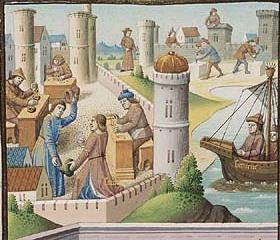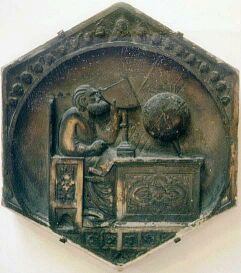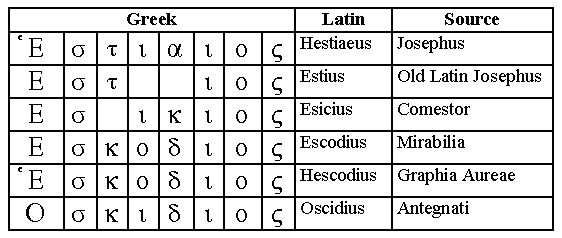| Noah goes to Cyprus and fathers Janus |
Venit autem Noe in Cyprum et ibi generacioni operam
dantes et agriculture filios genuerunt. Noe genuit Janum...
|
| Janus, son of Noah, father of Italy and called Janan in Genesis, practiced astrology, went to Italy and made
himself two camps, the first on the spot of 'St. Mary on the Janiculus', the second one at the sea shore |
Janus, filius Noe, pater Ytalie, iste in Genesi
dicitur Janan; hic dedit se astrologie et venit in Ytaliam, ubi nunc est Roma, et sibi edificavit castrum. Et usque
hodie in Roma est ecclesia, que dicitur sancta Maria ad Janiculum, ubi fuit castrum Jani. Aliud eciam castrum
edificavit in ripa maris nepoti suo eodem nomine appellato et Janum vocavit, ubi nunc est Janua civitas, quam
Troyani postmodum acreverunt.
|
| The giant Nimrod, from the line of Cham and 8 cubits heigh, desired to reign and
not knowing how, asked Janus, a wise man and astrologer, to teach him and by
his counsel he wanted to rule over the sons of Sem, who scorned him altogether |
Inter quos de filio quodam Cham nomine
Cus natus est quidam gygas nomine Nemprot, statura cubitorum octo, pulcher et fortis valde. Hic appetivit
dominari et nesciens modum, rogavit Janum, filium Noe, natum post diluvium, virum prudentissimum et astrologum,
ut doceret eum de modo regendi, cuius consilio voluit filiis Sem dominari, qui omnino sprevit eum.
|
| After the division of languages Janus went to Italy
with a large 'crowd', The building of the two camps. Japheth and his people
lived in other parts. Among the others, who were deified, Janus has been less bad according to Austin (City of God, book 7 chapt. 4) |
Post divisionem li[n]guarum Janus, filius Noe, navibus venit in Europam cum multitudine magna versus Ytaliam, ubi
nunc est Roma, et ibi finxit tentoria et fecit castrum, ubi nunc est sancta Maria ad Janiculum, et nepos eius eodem
nomine edificavit castrum Jani, ubi nunc Janua. Japhet cum suis populavit partes alias. Janus fuit inter alios minus
malus, qui dii facti sunt, secundum Augustinum.
|
| The exiled Saturn is received most gladly by Janus for his wisdom
and made co-ruler. Saturn taught the art of coining money, sowing grain, using sails,
saddles for horses and many miraculous things. He founded Saturniam.
On his advice Janus decreed that frankincense instead of oxen was sacrificed
to the gods like this: Appease the god with frankincense, let the calf be,
that it may grow up for the plough.
When Saturn died, Janus buried him with frankincense, deified him and instituted the Saturnalian plays |
 |
From Augustine, La Cité de Dieu c. 1475-1480,
MMW, 10 A 11, © Dutch Royal Library |
Saturnus navi fugit in Europam, quem Janus libentissime suscepit propter eius
sapienciam et consortem regni fecit. Hic Saturnus docuit formare monetas; ideo
in antiquis denariis Ytalie, in monetis, que inveniuntur in agris, ex una parte
est Janus, et ex alia parte navis, scilicet cum qua venit Saturnus in Sutrium
prope Romam. Frumentum primus in Europa seminavit, navigare cum velo docuit,
sellas equis invenit, unde dicuntur esse homines medii equi illi primi,
quia firmiter equitabant, et multa mira docuit, civitatem edificavit, usque
hodie Saturniam nominatam in territorio maritimo et calida balnea adinvenit,
ubi fui post. Thus non boves sacrificandum diis eius consilio Janus decrevit
juxta illud: Thure deum placa, vitulum sine, crescat aratro.
Unde a thure Thuscia dicta est. Unde versus: Thuscia thure deis legitur nunc
edere primum. Quo Saturno defuncto Janus cum thure eum sepelivit et deum fecit
et ludos instituit, et Saturnalia nuncupantur.
|
| The next king was the very wise Numa Pomfilius.
He added two months to a year, distinguished that there were twelve and
ordered the first to be january from Janus, named as the second february from
Februa, mother of the gods. The rest remained as before. |
Huic successit Numa Pomfilius, homo sagacissimus, qui duos menses addidit anno et duodecim esse
distinxit et ordinavit et primum a Jano Januarium, secundum a Februa, matre deorum,
nominavit Februarium, reliquos autem ut prius.
|

 ) means "Gift of God", which might bear some relation to the constant
references to the fact that he received his wisdom as a gift of God.
It therefore seems to me a feasible hypothesis that the original name of Noah's fourth son was Jonathan.
For the remainder of the text however I will stick to Jonitus.
) means "Gift of God", which might bear some relation to the constant
references to the fact that he received his wisdom as a gift of God.
It therefore seems to me a feasible hypothesis that the original name of Noah's fourth son was Jonathan.
For the remainder of the text however I will stick to Jonitus.

 is a Phoenician historian according to Lempriere's
Dictionary and John Gill's Expositor on Genesis 11.
When looking at the Greek version of the name, it is easy to imagine, how a small error by a copyist of a manuscript can
lead to various corruptions of a name.
is a Phoenician historian according to Lempriere's
Dictionary and John Gill's Expositor on Genesis 11.
When looking at the Greek version of the name, it is easy to imagine, how a small error by a copyist of a manuscript can
lead to various corruptions of a name. 